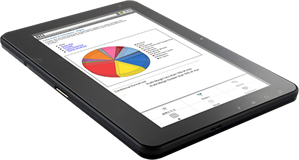Benefits of Mobile Business Intelligence (Part Two)
And we’re back. In part one of this blog series – Benefits of Mobile Business Intelligence (Part One) – we offered up some research from Mobile Business Intelligence (BI) guru, Howard Dresner, in conjunction with our own thoughts regarding the benefits of Mobile BI.
In part two, we’re exploring the opinions and research of some of the BI industry’s most notable analyst groups.

Aberdeen Group on Mobile Business Intelligence
A recent Aberdeen research report – Actionable Intelligence for the Agile Enterprise – identified several significant benefits of a mature Mobile BI deployment.
The key drivers for Mobile BI adoption
Respondents identified the three main drivers underpinning the adoption and implementation of Mobile BI as:
• The ability to achieve competitive advantage (54%)
• The ability to increase the productivity of mobile employees (41%)
• The ability to eliminate delays in alerting key decision-makers to critical information (30%)
Definition of Mobile BI maturity
The research report divides respondent organizations into three categories based on the maturity of their BI rollouts:
• Best-in-Class (Top 20% of aggregate performance scorers)
• Industry Average (Middle 50% of aggregate performance scorers)
• Laggard (Bottom 30% of aggregate performance scorers)
The Best-in-Class are distinguished from Industry Average and Laggard companies by two main performance criteria:
• Ability to find required information using Mobile BI
• Customer satisfaction
The criteria were measured over a 12 month period.
Benefits of Mobile BI
The report identified numerous notable benefits of Mobile BI deployments, including:
• Reduced time to information: Best-in-Class organizations are able to find required information to make critical business decisions 87% of the time compared to a 55% Industry Average and only 14% by Laggards.
• Reduced time to decision: Top performing organizations (Best-in-Class) achieved a “time-to-decision” of 3.8 hours, 1.7 times faster than the Industry Average, and over five times faster than Laggards.
• Increased customer satisfaction: Ninety-two percent of customers from Best-in-Class organizations reported being extremely or very satisfied, compared to 62% for Industry Average, and 13% for Laggard organizations.
• Increased executive performance: Executives at Best-in-Class organizations achieved 84% of personal KPIs, Industry Average executives 72%, and Laggard 69%.
• Increased revenue: Best-in-Class companies realized a 21% increase in revenue from last financial year, compared 12% from Industry Average organizations, and 6% from Laggards.
IDC on Mobile Business Intelligence
IDC’s European business analytics program manager, Alys Woodward, said that consuming BI via tablet computers will empower organizations to realize pervasive BI adoption and BI ROI.
Speaking at IDC’s Business Intelligence Conference 2011, Woodward suggested that the natural interactivity and uninhibited functionality (large screen), in conjunction with their portability, made tablets “the answer to BI execution in business”.
“What happens with a touchscreen tablet is that it takes things a step closer to the user,” she said. “You’re closer to the data, you can explore a little more richly than if you were using a mouse.”
“The best vendors are doing Mobile BI so that you write a report once and then that report can appear on whatever form factor people need it to be on, whether that’s a laptop, or a large screen, or a tablet,” she added.
“It’s helping with adoption and it’s helping bring execs on board with information and it really is something that’s quite powerful.”
Howard Dresner on Mobile Business Intelligence
Dresner concluded the official webcast launch of his updated 2011 Mobile Business Intelligence Market Study by declaring that the rapidly growing uptake and interest in Mobile BI meant that in the future, Mobile BI would not merely represent a growing facet of BI, but would become the main form of deliver for business analytics and the focal point of the entire industry.
“Moving forward I expect to see a rising tide across all segments, all classes of user, and all verticals,” said Dresner.
“I do believe that [Mobile BI] becomes fundamentally the new platform for Business Intelligence.”
Gartner expects that 33% of BI functionality will be consumed via mobile devices by 2013.
Yellowfin and Mobile Business Intelligence
Dresner’s 2011 Mobile BI study ranked the mobile capabilities of the globe’s most notable BI vendors. Vendors were ranked according to the number of mobile platforms supported, the level of platform integration and the number of BI features supported.
Yellowfin’s Mobile BI platform was awarded the second highest score with a total of 14 points out of a possible 20. The highest score achieved was 15.
According to a study by The Data Warehousing Institute (TDWI) in 2008, only 24% of the potential BI users are using BI solutions. Clearly there’s a lot of room for improvement and potential gains to be had.
At Yellowfin, we believe that the rate of end-user adoption is the best method for measuring the success of any BI solution, because the more people with access to the benefits of quality BI, the better equipped any organization will be to respond to, and take advantage of, opportunities and shifts in their business environment. Mobile BI is a major driver for pervasive BI deployments.
For more on Yellowfin’s Mobile BI capabilities, check out the mobile analytics features page.